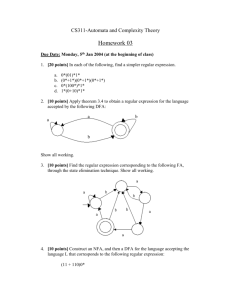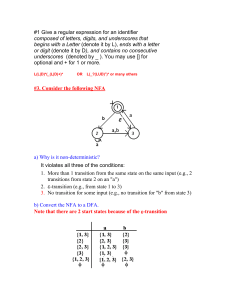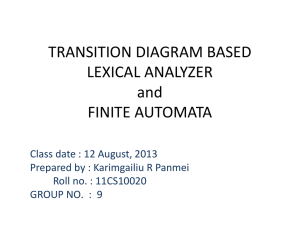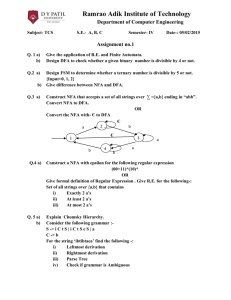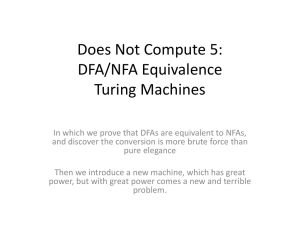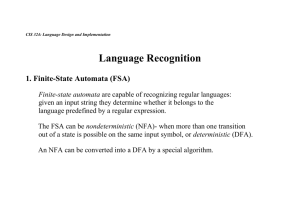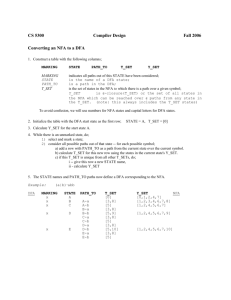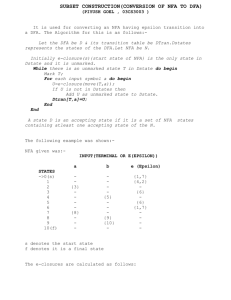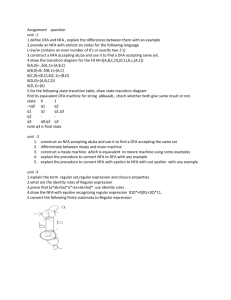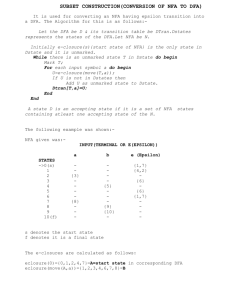02Lexical
advertisement
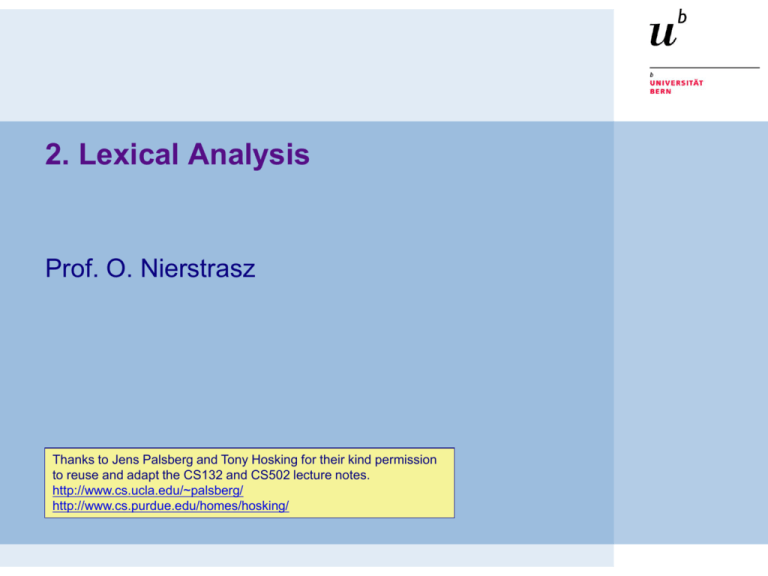
2. Lexical Analysis
Prof. O. Nierstrasz
Thanks to Jens Palsberg and Tony Hosking for their kind permission
to reuse and adapt the CS132 and CS502 lecture notes.
http://www.cs.ucla.edu/~palsberg/
http://www.cs.purdue.edu/homes/hosking/
Roadmap
>
>
>
>
Regular languages
Finite automata recognizers
From regular expressions to deterministic finite automata
Limits of regular languages
See, Modern compiler implementation
in Java (Second edition), chapter 2.
2
Roadmap
>
>
>
>
Regular languages
Finite automata recognizers
From regular expressions to deterministic finite automata
Limits of regular languages
3
Scanner
• map characters to tokens
x = x + y
<id,x> = <id,x> + <id,y>
• character string value for a token is a lexeme
• eliminates white space (tabs, blanks, comments etc.)
• a key issues is speed use specialized recognizer
4
Specifying patterns
A scanner must recognize various parts of the language’s syntax
Some parts are easy:
White space
<ws> ::= <ws> ’ ’
|
<ws> ’\t’
|
’’
|
’\t’
Keywords and operators
specified as literal patterns: do, end
Comments
opening and closing delimiters: /* … */
5
Specifying patterns
Other parts are much harder:
Identifiers
alphabetic followed by k alphanumerics (_, $, &, …))
Numbers
integers: 0 or digit from 1-9 followed by digits from 0-9
decimals: integer ’.’ digits from 0-9
reals: (integer or decimal) ’E’ (+ or —) digits from 0-9
complex: ’(’ real ’,’ real ’)’
We need an expressive notation to specify these patterns!
6
Operations on languages
A language is a set of strings
Operation
Definition
Union
L M = { s s L or s M }
Concatenation
LM = { st s L and t M }
Kleene closure
L* = I=0, Li
Positive closure
L+ = I=1, Li
7
Regular expressions describe regular
languages
Regular expressions over an alphabet :
1. is a RE denoting the set {}
2. If a , then a is a RE denoting {a}
3. If r and s are REs denoting L(r) and L(s), then:
>
>
>
>
>
(r) is a RE denoting L(r)
(r)(s) is a RE denoting L(r) L(s)
(r)(s) is a RE denoting L(r)L(s)
(r)* is a RE denoting L(r)*
If we adopt a precedence for operators, the extra
parentheses can go away. We assume closure, then
concatenation, then alternation as the order of precedence.
8
Examples
identifier
letter (a b c … z A B C … Z )
digit (0123456789)
id letter ( letter digit )*
numbers
integer (+— ) (0(123… 9) digit * )
decimal integer . ( digit )*
real ( integer decimal ) E (+ —) digit *
complex ’(‘ real ’,’ real ’)’
We can use REs to build scanners automatically.
9
Algebraic properties of REs
rs = sr
is commutative
r(st) = (rs)t
is associative
r (st) = (rs)t
concatenation is associative
r(st) = rsrt
(st)r = srtr
r = r
r = r
concatenation distributes over
r * = (r)*
is contained in *
r ** = r*
* is idempotent
is the identity for concatenation
10
Examples
Let = {a,b}
>
ab denotes {a,b}
>
(ab) (ab) denotes {aa,ab,ba,bb}
>
a* denotes {,a,aa,aaa,…}
>
(ab)* denotes the set of all strings of a’s and b’s
(including ), i.e., (ab)* = (a*b*)*
>
aa*b denotes {a,b,ab,aab,aaab,aaaab,…}
11
Roadmap
>
>
>
>
Regular languages
Finite automata recognizers
From regular expressions to deterministic finite automata
Limits of regular languages
12
Recognizers
From a regular expression we can construct a
deterministic finite automaton (DFA)
letter (a b c … z A B C … Z )
digit (0123456789)
id letter ( letter digit )*
13
Code for the recognizer
14
Tables for the recognizer
Two tables control the recognizer
char_class
next_state
char
a-z
A-Z
0-9
other
value
letter
letter
digit
other
letter
digit
other
0
1
3
3
1
1
1
2
2
—
—
—
3
—
—
—
To change languages, we can just change tables
15
Automatic construction
>
Scanner generators automatically construct code from
regular expression-like descriptions
— construct a DFA
— use state minimization techniques
— emit code for the scanner (table driven or direct code )
>
A key issue in automation is an interface to the parser
>
lex is a scanner generator supplied with UNIX
— emits C code for scanner
— provides macro definitions for each token (used in the parser)
16
Grammars for regular languages
Provable fact:
— For any RE r, there exists a grammar g such that L(r) = L(g)
The grammars that generate regular sets are called regular
grammars
Definition:
In a regular grammar, all productions have one of two forms:
1. A aA
2. A a
where A is any non-terminal and a is any terminal symbol
These are also called type 3 grammars (Chomsky)
17
More regular languages
Example: the set of strings containing an even number
of zeros and an even number of ones
The RE is (0011)*((0110)(0011)*(0110)(0011)*)*
18
More regular expressions
What about the RE (ab)*abb ?
State s0 has multiple transitions on a!
It is a non-deterministic finite automaton
19
Finite automata
A non-deterministic finite automaton (NFA) consists of:
1. a set of states S = { s0 , … , sn }
2. a set of input symbols (the alphabet)
3. a transition function move mapping state-symbol pairs to sets of
states
4. a distinguished start state s0
5. a set of distinguished accepting or final states F
A Deterministic Finite Automaton (DFA) is a special case of an NFA:
1. no state has a -transition, and
2. for each state s and input symbol a, there is at most one edge
labelled a leaving s.
A DFA accepts x iff there exists a unique path through the transition
graph from the s0 to an accepting state such that the labels along
the edges spell x.
20
DFAs and NFAs are equivalent
1. DFAs are clearly a subset of NFAs
2. Any NFA can be converted into a DFA, by simulating
sets of simultaneous states:
— each DFA state corresponds to a set of NFA states
— possible exponential blowup
21
Roadmap
>
>
>
>
Regular languages
Finite automata recognizers
From regular expressions to deterministic finite automata
Limits of regular languages
22
NFA to DFA using the subset construction:
example 1
23
Constructing a DFA from a regular expression
>
RE NFA
— Build NFA for each term; connect with moves
>
NFA DFA
— Simulate the NFA using the subset construction
>
DFA minimized DFA
— Merge equivalent states
>
DFA RE
— Construct Rkij = Rk-1ik (Rk-1kk)* Rk-1kj Rk-1ij
24
RE to NFA
25
RE to NFA example: (ab)*abb
(ab)
(ab)*
abb
26
NFA to DFA: the subset construction
add state P = -closure(s0)
Input: NFA N
unmarked to SD
Output: DFA D with states SD and
while unmarked state P in SD
transitions TD such that L(D) =
mark P
L(N)
for each input symbol a
Method: Let s be a state in N and
P be a set of states. Use the
U = -closure(move(P,a))
following operations:
if U SD
> -closure(s) — set of states of N
then add U unmarked to SD
reachable from s by transitions
alone
TD[T,a] = U
> -closure(P) — set of states of N
end for
reachable from some s in P by
end while
transitions alone
-closure(s0) is the start state of D
> move(T,a) — set of states of N to
which there is a transition on input a A state of D is accepting if it
from some s in P
contains an accepting state of N
27
NFA to DFA using subset construction:
example 2
A = {0,1,2,4,7}
B = {1,2,3,4,6,7,8}
C = {1,2,4,5,6,7}
D = {1,2,4,5,6,7,9}
E = {1,2,4,5,6,7,10}
A
B
C
D
E
a
B
B
B
B
B
b
C
D
C
E
C
28
Roadmap
>
>
>
>
Regular languages
Finite automata recognizers
From regular expressions to deterministic finite automata
Limits of regular languages
29
Limits of regular languages
Not all languages are regular!
One cannot construct DFAs to
recognize these languages:
L = { pkqk }
L = { wcwr w * }
In general, DFAs cannot count!
However, one can construct DFAs for:
• Alternating 0’s and 1’s:
( 1)(01)*( 0)
• Sets of pairs of 0’s and 1’s
(01 10)+
30
So, what is hard?
Certain language features can cause problems:
> Reserved words
— PL/I had no reserved words
— if then then then = else; else else = then
>
Significant blanks
— FORTRAN and Algol68 ignore blanks
— do 10 i = 1,25
— do 10 i = 1.25
>
String constants
— Special characters in strings
— Newline, tab, quote, comment delimiter
>
Finite limits
— Some languages limit identifier lengths
— Add state to count length
— FORTRAN 66 — 6 characters(!)
31
How bad can it get?
Compiler needs context
to distinguish variables
from control constructs!
32
What you should know!
What are the key responsibilities of a scanner?
What is a formal language? What are operators over
languages?
What is a regular language?
Why are regular languages interesting for defining
scanners?
What is the difference between a deterministic and a
non-deterministic finite automaton?
How can you generate a DFA recognizer from a regular
expression?
Why aren’t regular languages expressive enough for
parsing?
33
Can you answer these questions?
Why do compilers separate scanning from parsing?
Why doesn’t NFA DFA translation normally result in
an exponential increase in the number of states?
Why is it necessary to minimize states after translation a
NFA to a DFA?
How would you program a scanner for a language like
FORTRAN?
34
License
>
http://creativecommons.org/licenses/by-sa/2.5/
Attribution-ShareAlike 2.5
You are free:
• to copy, distribute, display, and perform the work
• to make derivative works
• to make commercial use of the work
Under the following conditions:
Attribution. You must attribute the work in the manner specified by the author or licensor.
Share Alike. If you alter, transform, or build upon this work, you may distribute the resulting
work only under a license identical to this one.
• For any reuse or distribution, you must make clear to others the license terms of this work.
• Any of these conditions can be waived if you get permission from the copyright holder.
Your fair use and other rights are in no way affected by the above.
35
